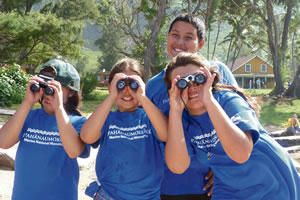School of Bird Barf
A new program gets students outdoors to learn about native species, and to dissect albatross boluses. Thanks to a curriculum developed for elementary schools by the National Oceanic and Atmospheric Administration (NOAA), young students are receiving hands-on lessons they won’t soon forget.

By .(JavaScript must be enabled to view this email address)
E-mail this story | Print this page | Archive | RSS

|
land animals. The plants at both are genetically linked, borne between the land masses by seabirds. Kaena is also home to a leina stone, a portal for souls departing from the earth toward the spirit realm in the direction of Papahanaumokuakea.
In the classroom, students were introduced to those islands, which are some of the most isolated in the world, with very little human footprint. They learned about endemic fish, whales, monk seals, sea birds, turtles, plants and insects, many of which are endangered, but are managing to flourish on the islands.
Next the children were presented with the concept of a “human footprint” our use and depletion of the earth’s resources such as energy and fossil fuels, as well as our disposal and mishandling of opala, particularly plastics. This is where the albatross come in their stomach contents are an excellent barometer of the cleanliness of our oceans.
“One of the workshops during the semester was on marine debris,” says IPA teacher Lisa Fabro. “The children ended up getting involved in the fifth annual International Marine Debris Conference held in Waikiki. Our children glued together amazing marine debris sculptures, which were used as centerpieces for the conference. About 440 people from 33 different countries attended and they voted on the sculptures. Our students were able to not only participate, but to get awards on their sculptures.”
Toward the end of the semester it was time for students to act on the knowledge they’d gained. They headed to Camp Erdman in Mokuleia for an overnight stay. There were four main components to their visit. They learned about flora, and participated in planting more than 100 native ohai, naio and naupaka (the rarer mountain type, rather than the common coastal variety) in a restoration site near Camp Erdman, the last outpost of civilization before heading into Kaena Point Natural Reserve.
Then they learned about the land by doing a makai to mauka hike, looking at the changing terrain and how that land was used in the past, with a discussion on possibilities for utilizing the resources in the future.
Third, they learned about animal life, which included dissecting not only albatross boluses, but also its equivalent: owl pellets. “The students were able to compare what an owl pellet from the Mainland has in it and what an albatross is throwing up on the Northwestern Hawaiian Islands,” explains Krueger. “There was all kinds of marine debris in the albatross, but in the owl pellet there was just bones and fur.
“We have a lot of budding activists on campus now. They’ll tell you ‘We’re part of the restoration generation.’”
After the sun set, the plan was to look skyward to study celestial bodies. But nature intervened. The day the IPA students happened to be on their overnight field excursion was the day the tsunami came rolling in from Japan and they had to evacuate from the shoreline.
Plans originally called for students to spend the second day interacting with Camp Erdman interns. “The interns come in from Brazil, Mexico, Africa, Canada, Norway all over the world,” says Limtiaco. “So the kids get to see this very worldly focus. They’re not only looking into their own culture and the things that are relevant here, they’re also looking at how people across the planet view this world and how really we all need to take part in protecting this planet because we all have a stake in it.”
The program was so successful that Limtiaco has decided to keep Kaena Point as the base camp for the Navigating Change program, and IPA has committed to participate for a second school year. Coincidentally, the theme of the program suited IPA perfectly. “IPA has sort of a mantra of the navigators,” notes Limtiaco. “The Navigators is their theme, it’s their team mascot, which harkens back to Navigating Change.”
Fabro’s vision for her students echoes Limtiaco’s goal with Navigating Change:
“Environmental education is a perfect (fit with) all areas of academia, and the children respond to it, they love it. It’s a great way to get them connected to where they live. That’s the change that we’re trying to help them navigate through. We firmly believe that if they’re connected and they care about where they live, they’re going to want to take care of it.”
Page 2 of 2 pages for this story < 1 2
E-mail this story | Print this page | Comments (0) | Archive | RSS
Most Recent Comment(s):








